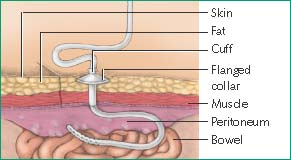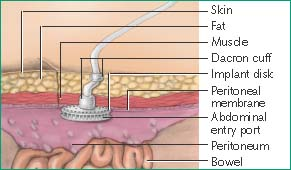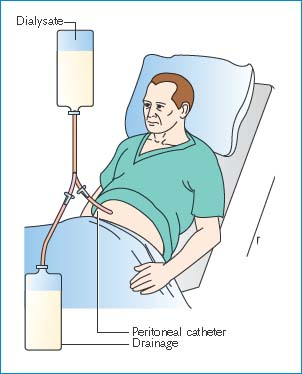Peritoneal Dialysis
Peritoneal dialysis is indicated for patients with end-stage renal disease who are looking for an alternative to renal replacement therapy. Peritoneal dialysis can also be used in patients with vascular access issues, chronic heart failure, and ischemic heart disease.1 In this procedure, dialysate—the solution instilled into the peritoneal cavity by a catheter—draws waste products, excess fluid, and electrolytes from the blood across the semipermeable peritoneal membrane. (See How peritoneal dialysis works.)
After a prescribed period, the dialysate is drained from the peritoneal cavity, removing impurities with it. The dialysis procedure is then repeated, using a new dialysate each time, until waste removal is complete and fluid, electrolyte, and acid-base balance has been restored. The procedure is also known as the dialysis cycle, consisting of the dialysate instillation phase, the dialysate dwell phase, and the dialysate drain phase.
Peritoneal dialysis is usually contraindicated in patients who have had extensive abdominal or bowel surgery or extensive
abdominal trauma, who are obese, or who have severe vascular disease or respiratory distress.
abdominal trauma, who are obese, or who have severe vascular disease or respiratory distress.
Comparing Peritoneal Dialysis Catheters
The first step in any type of peritoneal dialysis is insertion of a catheter to allow instillation of dialyzing solution. The surgeon may insert one of the three catheters described here.
Tenckhoff Catheter
To implant a Tenckhoff catheter, the surgeon inserts the first 6¾″ (17 cm) of the catheter into the patient’s abdomen. The next 2¾″ (7-cm) segment, which may have a Dacron cuff at one or both ends, is imbedded subcutaneously. Within a few days after insertion, the patient’s tissues grow around the cuffs, forming a tight barrier against bacterial infiltration. The remaining 37/8″ (10 cm) of the catheter extends outside of the abdomen and is equipped with a metal adapter at the tip that connects to dialyzer tubing.
 |
Flanged-Collar Catheter
To insert this kind of catheter, the surgeon positions its flanged collar just below the skin so that the device extends through the abdominal wall. He keeps the distal end of the cuff from extending into the peritoneum, where it could cause adhesions.
 |
Column-Disk Peritoneal Catheter
To insert a column-disk peritoneal catheter (CDPC), the surgeon rolls up the flexible disk section of the implant, inserts it into the peritoneal cavity, and retracts it against the abdominal wall. The implant’s first cuff rests just outside the peritoneal membrane, and its second cuff rests just underneath the skin.
Because the CDPC doesn’t float freely in the peritoneal cavity, it keeps inflowing dialyzing solution from being directed at the sensitive organs, which increases patient comfort during dialysis.
 |
The catheter may be inserted in the operating room or under sterile conditions on the nursing unit. Dialysis can be performed either manually or using an automatic or semiautomatic cycle machine. (See Comparing peritoneal dialysis catheters.)
Equipment
Prescribed dialysate (1-L, 2-L, or 3-L bags with prescribed dextrose concentration) ▪ dialysate warmer ▪ medication vials, as ordered ▪ bowl of antiseptic solution, as needed ▪ two face masks ▪ goggles and gown ▪ dialysis administration set with drainage bag ▪ three pairs of sterile gloves ▪ IV pole ▪ antiseptic skin cleaning swabs ▪ hypoallergenic tape ▪ antiseptic pads ▪ precut sterile drain dressings ▪ protective cap for catheter ▪ sterile 4″ × 4″ gauze pads ▪ small sterile plastic clamp ▪ 10-mL syringe with 22G 1½″ needle, as needed ▪ specimen containers with labels, as needed ▪ laboratory request form, as needed ▪ straight catheterization kit, as needed.
Preparation of Equipment
Place the dialysate bags in the commercial dialysate warmer set at 98.6°F (37°C) for about 1 hour to ensure the dialysate is at body temperature. Warming the dialysate decreases the patient’s discomfort during the procedure and reduces vasoconstriction of the peritoneal capillaries. Dilated capillaries enhance blood flow to the peritoneal membrane surface, thus increasing waste clearance into the peritoneal cavity. Prescribed medications should be added
to the dialysate bag immediately before the dialysate will be hung and used. Disinfect multidose vials by soaking them in a bowl of antiseptic solution for 5 minutes before use.
to the dialysate bag immediately before the dialysate will be hung and used. Disinfect multidose vials by soaking them in a bowl of antiseptic solution for 5 minutes before use.
Implementation
Verify the doctor’s order for dialysis and dialysate to be used.2
Perform hand hygiene, put on a gown, sterile gloves, and a face mask, and follow standard precautions.3,4,5
Stay updated, free articles. Join our Telegram channel

Full access? Get Clinical Tree


Get Clinical Tree app for offline access

